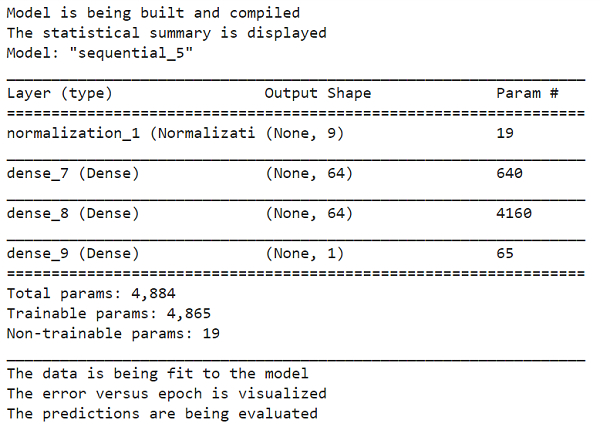如何使用 TensorFlow 将 DNN(深度神经网络)模型用于预测 Auto MPG 数据集上的 MPG 值?
pythonserver side programmingprogrammingtensorflow
Tensorflow 是 Google 提供的机器学习框架。它是一个与 Python 结合使用的开源框架,用于实现算法、深度学习应用程序等。它用于研究和生产目的。Tensor 是 TensorFlow 中使用的数据结构。它有助于连接流程图中的边缘。此流程图称为"数据流图"。张量不过是多维数组或列表。
"tensorflow"可以使用以下代码行在 Windows 上安装软件包 −
pip install tensorflow
回归问题的目的是预测连续或离散变量的输出,例如价格、概率、是否下雨等等。
我们使用的数据集称为"Auto MPG"数据集。它包含 20 世纪 70 年代和 80 年代汽车的燃油效率。它包括重量、马力、排量等属性。有了这个,我们需要预测特定车辆的燃油效率。
我们使用 Google Colaboratory 来运行以下代码。Google Colab 或 Colaboratory 有助于在浏览器上运行 Python 代码,并且需要零配置和免费访问 GPU
(图形处理单元)。Colaboratory 是在 Jupyter Notebook 之上构建的。以下是代码片段 −
示例
print("Model is being built and compiled")
dnn_model = build_compile_model(normalizer)
print("The statistical summary is displayed ")
dnn_model.summary()
print("The data is being fit to the model")
history = dnn_model.fit(
train_features, train_labels,
validation_split=0.2,
verbose=0, epochs=100)
print("The error versus epoch is visualized")
plot_loss(history)
print("The predictions are being evaluated")
test_results['dnn_model'] = dnn_model.evaluate(test_features, test_labels, verbose=0)
pd.DataFrame(test_results, index=['Mean absolute error [MPG]']).T
代码来源 − https://www.tensorflow.org/tutorials/keras/regression
输出


解释
模型已构建并编译。
使用‘summary’函数显示计数、平均值、中位数等统计值。
此编译模型适合数据。
在控制台上绘制了步骤数与预测误差的可视化。
与线性回归相比,使用 DNN 更好。


